 God has a sense of humor. How else to explain the fact that for the past three or four years I have been a founding and contributing member of the Mathical Book Award committee? Yep, each year I read a slew of math-related books for kids. I do it because while I personally was not overawed by integers as a child (aside from enjoying the PBS show Square One, of course), there are a lot of kids out there who are. Where are their books? Since the founding of the award, it’s not as if the number of quality math books have increased significantly over the past few years. That said, I have begun to notice them more astutely.
God has a sense of humor. How else to explain the fact that for the past three or four years I have been a founding and contributing member of the Mathical Book Award committee? Yep, each year I read a slew of math-related books for kids. I do it because while I personally was not overawed by integers as a child (aside from enjoying the PBS show Square One, of course), there are a lot of kids out there who are. Where are their books? Since the founding of the award, it’s not as if the number of quality math books have increased significantly over the past few years. That said, I have begun to notice them more astutely.
Here are the best and the brightest relating to math in 2016. Books that even an entirely right-side-of-the-brain kid will appreciate on some level. And to keep it fair, I’m highlighting both books that incorporate math into the text and stories about mathematicians themselves.
2016 Math Picture Books
Counting Books
Billions of Bricks: A Counting Book About Building by Kurt Cyrus
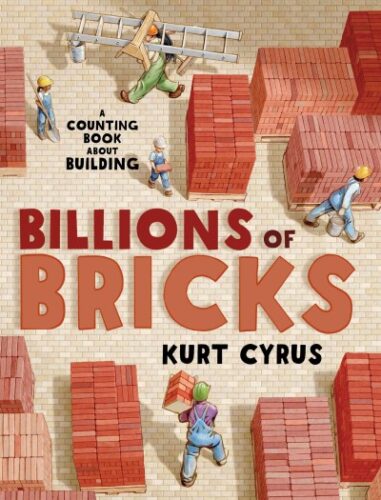
I’m sort of stretching the definition of what constitutes a counting book as far as I possibly can. That said, this picture book is a subtle little number, implying to the reader that counting and math are essential when it comes to construction and architecture. It’s never explicitly stated, but you could explain it pretty easily after reading the book. Give it a go!
Counting in the Garden by Emily Hruby, ill. Patrick Hruby

I’m not always a fan of digital art, but there was something deeply satisfying in how the Hrubys chose to display the plants, insects, and animals of this book. From a design standpoint alone I think it’s notable. The counting is just the icing on the cake.
It’s Not Easy Being Number Three by Drew Dernavich

Not technically a counting book but since it involves numbers I figured it could fit in here. The number three decides it’s had enough and is quitting its job. It enters the real world, taking on different professions, before it becomes clear that the world is a lesser place without threes.
Octopuses One to Ten by Ellen Jackson, ill. Robin Page

Who doesn’t love octopuses? Particularly when you get to count them? At long last these odd alien-looking creatures get their due. Page’s work on the art is truly stunning as well.
1 Big Salad: A Delicious Counting Book by Juana Medina
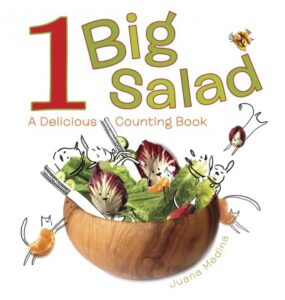 I’ve grown very fond of counting books that include healthy food, these days. Anything that allows me to promote tasty veggies to my impressionable small children AND covers counting is gold in my book.
I’ve grown very fond of counting books that include healthy food, these days. Anything that allows me to promote tasty veggies to my impressionable small children AND covers counting is gold in my book.
Swallow the Leader: A Counting Book by Danna Smith, ill. Kevin Sherry
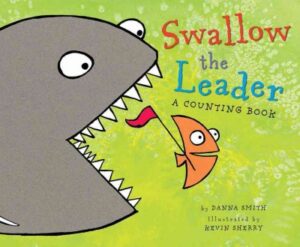
First thought upon seeing this cover was to be reminded of Victoria Chess’s magnificent Ten Sly Piranhas. This lacks that book’s courage of its convictions, but is still a really fun and lovely reverse counting book.
Biographies
Ada Lovelace, Poet of Science: The First Computer Programmer by Diane Stanley, ill. Jessie Hartland

It never rains but it pours. Last year saw the publication of one picture book biography of Ada Lovelace. This year has produced two, with more on the way in the future, I’m sure.
Ada’s Ideas: The Story of Ada Lovelace, the World’s First Computer Programmer by Fiona Robinson

The crazy thing is, for all that they’re so strongly different from one another, there are elements that I like in both.
Real World Applications
Animals by the Numbers: A Book of Infographics by Steve Jenkins
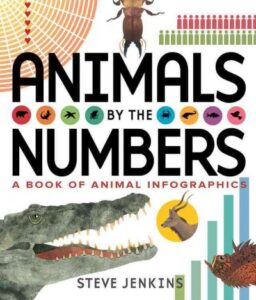
Do kids actually like infographics? I’ve never been able to answer that question so hopefully they do. Particularly when the visuals are as stunnng as the ones you’ll find here.
How Much Does a Ladybug Weigh? by Alison Limentani
I give full credit to my discovery of this book to New York Public Library’s recent release of its 100 Best Books of 2016 list. Had they not highlighted it, I never would have found it on my own. In this book it starts slowly with small animals. Oh, here, I’ll give you an interior visual:
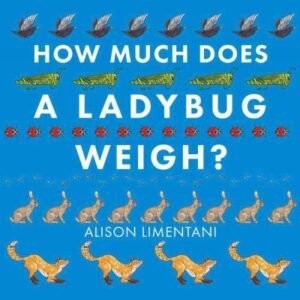
 On the next page that one grashopper has become two and you get to see what two grass hoppers weigh as much as.
On the next page that one grashopper has become two and you get to see what two grass hoppers weigh as much as.
Place Value by David Adler
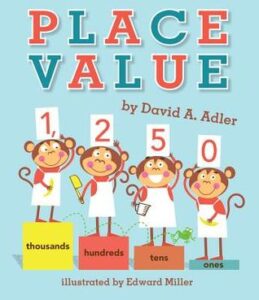
To be fair, Circles was another Adler title this year, but if I had to choose between that and this, this would win every time. Cheeky monkey chefs walk your kid through different numerical values. Probably the smartedst explanation I’ve seen in a book for kids to date.
For Older Readers
I know this list says it’s just for picture books, but I’d be amiss if I didn’t include two of my favorite notes.
Rebel Genius by Michael Dante DiMartino
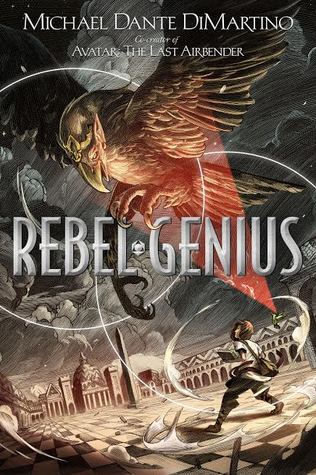
A co-creator of Avatar: The Last Airbender came out with a middle grade novel this year and it’s certainly exciting to read. In the book, students must learn geometry to fulfill their tasks. There’s not a ton of geometry in the book, mind you, but there’s just enough to keep you coming back for more.
Secret Coders by Gene Luen Yang

How on earth did Gene Luen Yang convince his good people to allow him to produce a graphic novels series on coding? That man must have magical powers.
December 1 – Board Books
December 2 – Board Book Adaptations
December 3 – Nursery Rhymes
December 4 – Picture Book Readalouds
December 5 – Rhyming Picture Books
December 6 – Alphabet Books
December 7 – Funny Picture Books
December 8 – Calde-Nots
December 9 – Picture Book Reprints
December 10 – Math Picture Books
December 11 – Bilingual Books
December 12 – International Imports
December 13 – Books with a Message
December 14 – Fabulous Photography
December 15 – Fairy Tales / Folktales
December 16 – Oddest Books of the Year
December 17 – Older Picture Books
December 18 – Easy Books
December 19 – Early Chapter Books
December 20 – Graphic Novels
December 21 – Poetry
December 22 – Fictionalized Nonfiction
December 23 – American History
December 24 – Science & Nature Books
December 25 – Transcendent Holiday Titles
December 26 – Unique Biographies
December 27 – Nonfiction Picture Books
December 28 – Nonfiction Chapter Books
December 29 – Novel Reprints
December 30 – Novels
December 31 – Picture Books

 The Boy Who Loved Math: The Improbable Life of Paul Erdős
The Boy Who Loved Math: The Improbable Life of Paul Erdős
By Deborah Heiligman
Illustrated by LeUyen Pham
Roaring Brook (an imprint of Macmillan)
ISBN: 978-1-59643-307-6
Ages 6 and up
On shelves June 25th
Make a beeline for your local library’s children’s biography section and learn firsthand the shocking truth about picture book bios of mathematical geniuses. Apparently there was only one and his name was Einstein. End of story. The world as we know it is not overflowing with picture book encapsulations of the lives of Sir Isaac Newton or Archimedes (though admittedly you could probably drum up a Leonardo da Vinci book or two if you were keen to try). But when it comes to folks alive in the 20th century, Einstein is the beginning and the end of the story. You might be so foolish as to think there was a good reason for that fact. Maybe all the other mathematicians were dull. I mean, Einstein was a pretty interesting fella, what with his world-shattering theories and crazed mane. And true, the wild-haired physicist was fascinating in his own right, but if we’re talking out-and-out interesting people, few can compare with the patron saint of contemporary mathematics, Paul Erdős. Prior to reading this book I would have doubted a person could conceivably make an engaging biography chock full to overflowing with mathematical concepts. Now I can only stare in amazement at a story that could conceivably make a kid wonder about how neat everything from Euler’s map of Konigsburg to the Szekeres Snark is. This is one bio you do NOT want to miss. A stunner from start to finish.
For you see, there once was a boy who loved math. His name was Paul and he lived in Budapest, Hungary in 1913. As a child, Paul adored numbers, and theorems, and patterns, and tricky ideas like prime numbers. As he got older he grew to be the kind of guy who wanted to do math all the time! Paul was a great guy and a genius and folks loved having him over, but he was utterly incapable of taking care of himself. Fortunately, he didn’t have to. Folks would take care of Paul and in exchange he would bring mathematicians together. The result of these meetings was great strides in number theory, combinatorics, the probabilistic method, set theory, and more! Until the end of this days (when he died in a math meeting) Paul loved what he did and he loved the people he worked with. “Numbers and people were his best friends. Paul Erdős had no problem with that.”
There are two kinds of picture book biographies in this world. The first attempts to select just a single moment or personality quirk from a person’s life, letting it stand in as an example of the whole. Good examples of this kind of book might include Me…Jane by Patrick McDonnell about the childhood of Jane Goodall or Lincoln Tells a Joke: How Laughter Saved the President And the Country by Kathleen Krull. It’s hard to pinpoint the perfect way to convey any subject, but it can sometimes be even harder to tell an entire life in the span of a mere 40 pages or so. Still, that tends to be the second and more common kind of picture book biography out there. Generally speaking they don’t tend to be terribly interesting. Just a series of rote facts, incapable of making it clear to a kind why a person mattered aside from the standard “because I said so” defense. The Boy Who Loved Math is different because it really takes the nature of biography seriously. If the purpose of a bio is to make it clear that a person was important, how important was a guy who loved math puzzles? Well, consider what the story can do. In a scant number of pages author Deborah Heiligman gives us an entire life synthesized down to just a couple key moments, giving the man’s life form and function and purpose, all while remaining lighthearted and fun to read. Who does that?
Did you know that there are kids out there who like math? I mean, reeeeeeally like math? The kinds that beg their parents for math problems to solve? They exist (heck, Ms. Heiligman gave birth to one) and for those kids this book will come like a present from on high. Because not only does the author highlight a fellow who took his passion for numbers and turned it into a fulfilling and fun life, but thanks to illustrator LeUyen Pham the illustrations are overflowing with math equations and puzzles and problems, just waiting to be interpreted and dissected. I have followed the career of Ms. Pham for many years. There is no book that she touches that she does not improve with her unique style. Whether it’s zeroing in on a child’s neuroses in Alvin Ho or bringing lush life to a work of poetry as in A Stick Is an Excellent Thing, Pham’s art can run the gamut from perfect interstitial pen-and-inks to lush watercolor paints. I say that, but I have never, but ever, seen anything like what she’s done in The Boy Who Loved Math.
It would not be overstating the matter to call this book Pham’s masterpiece. The common story behind its creation is that there was some difficulty finding the perfect artist for it because whosoever put pen to paper here would have to be comfortable on some level with incorporating math into the art. Many is the artist who would shy away from that demand. Not Ms. Pham. She takes to the medium like a duck to water, seemingly effortlessly weaving equations, charts, diagrams, numbers, and theorems into pictures that also have to complement the story, feature the faces of real people, capture a sense of time (often through clothing) and place (often through architecture), and hardest of all, be fun to look at.
But that’s just for starters. The final product is MUCH more complex. I’m not entirely certain what the medium is at work here but if I had to guess I’d go with watercolors. Whatever it is, Pham’s design on each page layout is extraordinary. Sometimes she’ll do a full page, border to border, chock full of illustrations of a single moment. That might pair with a page of interstitial scenes, giving a feel to Paul’s life. Or consider the page where you see a group of diners at a restaurant, their worlds carefully separated into dotted squares (a hat tip to one of Paul’s puzzles) while Paul sits in his very own dotted pentagon. It’s these little touches that make it clear that Paul isn’t like other folks. All this culminates in Pham’s remarkable Erdős number graph, where she outdoes herself showing how Paul intersected with the great mathematicians of the day. Absolutely stunning.
Both Heiligman and Pham take a great deal of care to tell this tale as honestly as possible. The extensive “Note From the Author” and “Note From the Illustrator” sections in the back are an eye-opening glimpse into what it takes to present a person honestly to a child audience. In Pham’s notes she concedes when she had to illustrate without a guide at hand. For example, Paul’s babysitter (“the dreaded Faulein”) had to be conjured from scratch. She is the rare exception, however. Almost every face in this book is a real person, and it’s remarkable to look and see Pham’s page by page notes on who each one is.
Heiligman’s author’s note speaks less to what she included and more to what she had to leave out. She doesn’t mention the fact that Paul was addicted to amphetamines and honestly that sort of detail wouldn’t have served the story much at all. Similarly I had no problem with Paul’s father’s absence. Heiligman mentions in her note what the man went through and why his absences would make Paul’s mother the “central person in his life emotionally”. The book never denies his existence, it just focuses on Paul’s mother as a guiding force that was perhaps in some way responsible for the man’s more quirky qualities. The only part of the book that I would have changed wasn’t what Heiligman left out but what she put in. At one point the story is in the midst of telling some of Paul’s more peculiar acts as a guest (stabbing tomato juice cartons with knives, waking friends up at 4 a.m. to talk math, etc.). Then, out of the blue, we see a very brief mention of Paul getting caught by the police when he tried to look at a radio tower. That section is almost immediately forgotten when the text jumps back to Paul and his hosts, asking why they put up with his oddities. I can see why placing Paul in the midst of the Red Scare puts the tale into context, but I might argue that there’s no real reason to include it. Though the Note for the Author at the end mentions that because of this act he wasn’t allowed back in the States for a decade, it doesn’t have a real bearing on the thrust of the book. As they say in the biz, it comes right out.
I have mentioned that this book is a boon for the math-lovers of the world, but what about the kids who couldn’t care diddly over squat about mathy malarkey? Well, as far as I’m concerned the whole reason this book works is because it’s fun. A little bit silly too, come to that. Even if a kid couldn’t care less about prime numbers, there’s interest to be had in watching someone else get excited about them. We don’t read biographies of people exactly like ourselves all the time, because what would be the point of that? Part of the reason biographies even exist is to grant us glimpses into the lives of the folks we would otherwise never have the chance to meet. Your kid may never become a mathematician, but with the book they can at least hang out with one.
One problem teachers have when they teach math is that they cannot come up with a way to make it clear that for some people mathematics is a game. A wonderful game full of surprises and puzzles and queries. What The Boy Who Loved Math does so well is to not only show how much fun math can be on your own, it makes it clear that the contribution Paul Erdős gave to the world above and beyond his own genius was that he encouraged people to work together to solve their problems. Heiligman’s biography isn’t simply the rote facts about a man’s life. It places that life in context, gives meaning to what he did, and makes it clear that above and beyond his eccentricities (which admittedly make for wonderful picture book bio fare) this was a guy who made the world a better place through mathematics. What’s more, he lived his life exactly the way he wanted to. How many of us can say as much? So applause for Heiligman and Pham for not only presenting a little known life for all the world to see, but for giving that life such a magnificent package as this book. A must purchase.
On shelves June 25th
Source: Advanced readers galley sent from publisher for review.
Like This? Then Try:
Misc:






 The Chicken Problem
The Chicken Problem
By Jennifer Oxley and Billy Aronson
Random House
$16.99
ISBN: 978-0-375-86989-1
Ages 3-7
On shelves now.
I was once in Prospect Park in Brooklyn when I passed a very small child wearing a porkpie hat running as fast as his chubby legs could carry him. Behind him his father yelled out (to little avail), “Pontius! Pontius, slow down!” I mention this because there is a particular Brooklyn aesthetic to a picture book like The Chicken Problem. Consider, if you will, its heroine Peg. Here she is sporting a mighty trendy little outfit replete with striped tights and buckled red boots. Even her name, Peg, suggests that she was named after Peggy Lee or someone of equal caliber. Notice too that she’s playing a ukulele on the endpapers and that pretty much clinches it. Peg is trendy. Too trendy for your preschooler? Not in the least. Peg may be a specific type of heroine peculiar to a single geographical location but with her urbane Cat and her trouble with high-spirited chicks this is one of those memorable heroines and one-on-one readalouds that add a little bit of math to a little bit of story alongside a whole lot of fine and beautiful art to bring us one fine fine book.
It’s a bright and beautiful day when young Peg and her cat Cat go to the farm to have a perfect picnic with a pig. Peg is one of those girls who like everything to be just so, and when she discovers that she accidentally cut an extra slice of pie she feels it’s a dire problem. Cat solves the imbalance by removing a very small chick from a nearby coop and surely that would be the end of that . . . if he’d managed to remember to close the coop door. Suddenly one hundred chickens are free and roaming the farm. It’s up to Peg, Cat, and maybe that pig they picked up, to figure out a way to cajole these freedom loving fowl into returning from whence they came. When that mission is finally accomplished that leaves one final matter: Time for pie!
I’ve read the occasional professional review that snarked about the svelte story found here, but to be honest I was rather charmed by it. It’s not the most dire straits that Peg and Cat must escape but in the simplest sense it’s a story with a mistake, a solution, and a conclusion that feels satisfying. The language itself repeats in good ways and sounds pleasant on the tongue (“The pie was fresh and juicy and gooey”) while the plot appeals to the pint-sized obsessive compulsives out there that insist that everything be exactly right.
The art is particularly charming, though I found I couldn’t figure out the medium. If I was going to harbor a guess I’d say that it was digital art doing a stand-up and cheer imitation of mixed media. I might have figured it to be done by hand, were it not for the fact that on more than one occasion a chicken will repeat in a large crowd scene. No matter, since it’s the charm of the characters that ultimately pull this puppy through. Peg, noseless though she may be, is a likeable soul. Cat, a feline I initially considered lacking in smiles, turns out to have quite a bit of nuance to his rotund eggplant-like little body. The pig is always referred to as “a pig”, as if he were just some barnyard stray the duo stumbled over on their travels. He seems so content wherever he is, legs neatly crossed beneath him, that you suspect he’d follow Peg and Cat to the ends of the earth if they asked. As for the chickens themselves, they’re beautifully expressionless and yet you spend a lot of your time just trying to keep up with their antics.
Speaking of endpapers, I’ve seen inside jokes in my day. I’ve seen clever details and little pokes of fun. What I have never seen are endpapers that are SO o’erfilled with details and ideas that you could spend the better part of twenty minutes parsing them. It is important to know that the front endpapers are incredibly different from the back endpapers. I mention this in part because I know that libraries have a tendency to glue their bookflaps to their books’ front and back covers and the result is going to cover up quite a bit of content. At the front of the book you can find six scenes drawn from Peg and Cat’s adventures. Sometimes they might be rowing George Washington over the Delaware while other times they’re jamming with a band of bears. Quick flip to the back of the book and you’ve the strangest collection of one hundred chickens you ever did see. An explanation is provided in the special thanks section. It says, “And, for posing so patiently for the pictures, the one hundred chickens,” and then names each and every last one of them. It took a while for me to realize that the names correspond with the pictures on the opposite page. I had already looked at the pictures of the chicks before and noticed odd details about them (like the fact that one of them resembled President Obama on his HOPE poster) but didn’t realize that each one had a name (“Barawk Obama”). Look closely enough and you’ll find references to Lady Gaga, Mahatma Gandhi, Rumpelstiltskin, St. John, George Bernard Shaw, and many others. My personal favorite was the preppy turtleneck donning Cluck C. Cluck III. Even without reading his name I knew he was a 1% chicken, if you know what I mean.
As the bookflaps explain, Peg and Cat are well on their way to becoming a television series on PBS that teaches preschoolers math someday. And while that might account for some of the adventures on the endpapers, the story stands perfectly well on its own. I don’t need to see Peg on my TiVo to know she’s a special kind of kid. Whether or not the show occurs, I do hope that we’ll see more of Peg and her erstwhile purple companion on good old-fashioned paper and board in the future. I suspect folks will end up picking up the book more for the art and story than the math, and that’s okay. Fun pretty much sums it up.
On shelves now.
Source: Final copy sent from publisher for review.
Like This? Then Try:
Interview: Nerdy Book Club
Video:
There was a cute little book trailer, of course:
And though its website is gone, you get a pretty clear sense of Peg, Cat and their world here.

I am now entertaining the ridiculous hope that when the show premiers they make Peg-with-ukelele YouTube videos like the millions already out there. Just Peg, a ukelele, a blank wall, and one of her songs. I mean, might as well at this point, right?
 God has a sense of humor. How else to explain the fact that for the past three or four years I have been a founding and contributing member of the Mathical Book Award committee? Yep, each year I read a slew of math-related books for kids. I do it because while I personally was not overawed by integers as a child (aside from enjoying the PBS show Square One, of course), there are a lot of kids out there who are. Where are their books? Since the founding of the award, it’s not as if the number of quality math books have increased significantly over the past few years. That said, I have begun to notice them more astutely.
God has a sense of humor. How else to explain the fact that for the past three or four years I have been a founding and contributing member of the Mathical Book Award committee? Yep, each year I read a slew of math-related books for kids. I do it because while I personally was not overawed by integers as a child (aside from enjoying the PBS show Square One, of course), there are a lot of kids out there who are. Where are their books? Since the founding of the award, it’s not as if the number of quality math books have increased significantly over the past few years. That said, I have begun to notice them more astutely. I’ve grown very fond of counting books that include healthy food, these days. Anything that allows me to promote tasty veggies to my impressionable small children AND covers counting is gold in my book.
I’ve grown very fond of counting books that include healthy food, these days. Anything that allows me to promote tasty veggies to my impressionable small children AND covers counting is gold in my book. On the next page that one grashopper has become two and you get to see what two grass hoppers weigh as much as.
On the next page that one grashopper has become two and you get to see what two grass hoppers weigh as much as.

















Animals by the Numbers is one of my favorite books of the year. I love how Steve Jenkins did scrupulous researched to find facts that highlight fascinating patterns in nature, compiled data sets to show each concept to its best advantage, and then developed an astonishing range of visual representations to make the information accessible to kids with a wide range of learning styles. The amount of creative thinking required to synthesize the complex ideas and information in this book and conceptualize a fresh way to reach his young audience proves to me, once again, that Steve Jenkins is a genius. If I were on the Newbery committee, I would fight hard for this book.
Thank you! Considering I wrote this list in a state of near exhaustion, you’ve said precisely what I should have and didn’t.
Thanks YOU, Betsy, for compiling this list. It’s terrific.